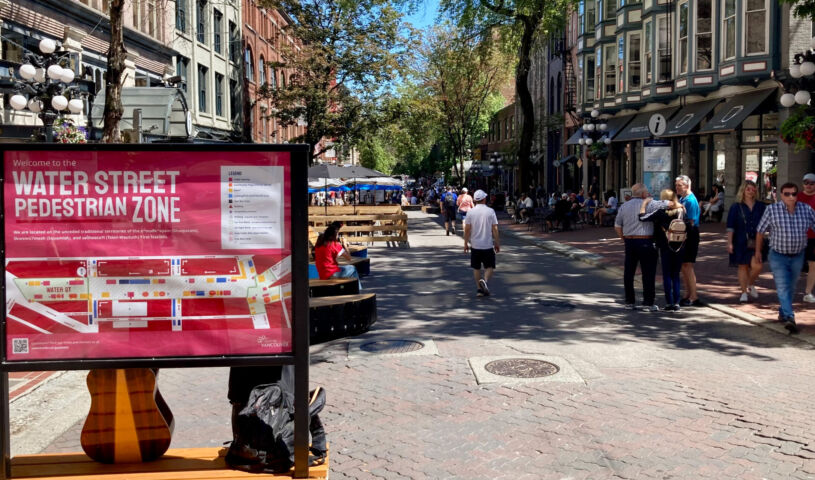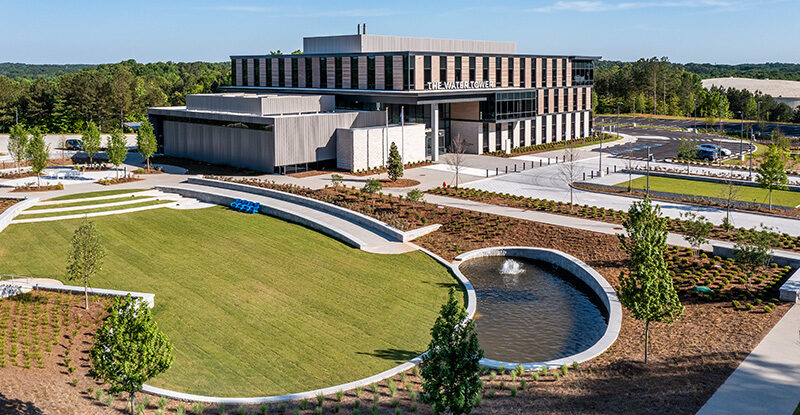Vancouver’s Gastown goes car free this summer
 Part of Vancouver’s historic Gastown neighbourhood is going car-free this summer to make the area more pedestrian-friendly. Photo: Ibrahim Daair
Part of Vancouver’s historic Gastown neighbourhood is going car-free this summer to make the area more pedestrian-friendly. Photo: Ibrahim Daair
Part of Vancouver’s historic Gastown neighbourhood is going car-free this summer to make the area more pedestrian-friendly.
Over July and August, part of Water Street between Cambie St. and West Cordova St. will be closed to cars as part of a pilot project. In addition, Maple Tree Square will also be pedestrianized, while the area between will only permit local vehicle access.
On July 4, officials from the City of Vancouver and members of the Sḵwx̱wú7mesh Úxwumixw (Squamish Nation) and səlilwətaɬ (Tsleil-Waututh Nation) gathered to celebrate the official opening of the pedestrian zone.
“I’m beyond excited to officially kick off the Water Street Pedestrian Zone,” said Vancouver Mayor Ken Sim. “We’ve partnered closely with Musqueam, Squamish, and Tsleil-Waututh Nations to bring their rich cultures to life here in Gastown.”
People-First Streets
The city says the Water Street Pedestrian Zone is a vibrant and activated “people-first” place that supports business and community connections. It includes car-free and car-light sections and features shared seating, expanded patios, merchandise displays, storytelling and artwork courtesy of the local First Nations, live performances and special events.
“This is a step toward a more inclusive and vibrant community, supported by our UNDRIP Action Plan and our council’s commitment to uplifting this iconic neighbourhood and creating a world-class city,” Sim said.
First Nations welcomed the pilot, saying it will help increase the visibility of local Indigenous cultures.
“We have been out of sight and out of mind on our own lands, for far too long,” said Sxwíxwtn Wilson Williams, Sḵwx̱wú7mesh Úxwumixw spokesperson and council member. “Lekleki (Gastown) is one of the most historic neighbourhoods in K’emk’emeláy̓ (Vancouver).”
As part of the Gastown Public Spaces Plan, and this summer’s Water Street Pedestrian Zone Pilot, the city is working to advance Reconciliation with the local First Nations and support their visibility on their lands.
As an initial step, the Water Street pilot features:
- planter art wraps completed by Sḵwx̱wú7mesh children of Xwemélch’stn Etsimxwawtxw (Capilano Little Ones School) from K4 to Grade 5 art piece for Earth Day 2024; and səlilwətaɬ artists Jordan Gallie, Jonas Jones, and Zac George
- storytelling boards sharing the history of Sḵwx̱wú7mesh Úxwumixw, the place name Sḵwx̱wú7mesh has for Gastown, the history of səlilwətaɬ and Burrard Inlet, and what we can do now to restore the Inlet for the future
- welcome translations on sandwich board signage in the local First Nations languages Hən̓q̓əmin̓əm: ʔəm̓i ce:p and Sḵwx̱wú7mesh Sníchim: i chap tl’iḵ
“The Water Street Pedestrian Zone Pilot is part of our ongoing collaboration with the City of Vancouver to support making Gastown more people-friendly,” said Chief Jen Thomas, of the səlilwətaɬ (Tsleil-Waututh Nation). “As part of this pilot, storyboards and planter box wraps will display vibrant artwork by Tsleil-Waututh Nation artists Olivia George, Jordan Gallie, and Jonas Jones. I look forward to seeing Water Street become a more welcoming space for all.”
City staff budgeted $1.3 million for the pedestrian zone pilot. That includes money for traffic management and transportation changes, furniture and planters, community programming supports, sanitation and stewardship supports, monitoring, and data collection.
The Gastown pilot is part of the city’s broader Vancouver Plan, which provides a framework for what officials want the city to look like by 2050. Approved by the Vancouver City Council in July 2022, the plan is meant to guide the long-term growth of the city by detailing where growth and change will occur over the next 30 years.
“We will change our streets to improve walking, biking, and transit and create more space to manage water, create ecological corridors, and for people to gather and enjoy the outdoors,” the plan document reads.
Car-Free Streets Catching On
More Canadian cities have been pedestrianizing streets in recent years.
In April, Montreal announced that 11 streets in the city with be pedestrianized over this summer. City officials say jut under 9.5 kilometres of street have been designated for pedestrians. In addition, this year marks the first time the area near Plaza Saint-Hubert will be car-free for the summer.
“Since their inception, pedestrianized streets have been the lifeblood of Montreal’s neighbourhoods,” said Montreal Mayor Valérie Plante. “We know that the development and animation of arteries are essential conditions for improving the commercial experience, which begins on the street.”
The City of Toronto is also working on pedestrianizing part of Yonge Street and High Park. Edmonton, Calgary, Halifax, and Hamilton are among the other Canadian cities experimenting with the idea of pedestrianizing streets.
Beyond making streets more people-friendly, deprioritizing cars can help make neighbourhoods quieter and less polluted. In Paris, car-free days have reduced ambient noise levels in the surrounding area by up to 2.5 decibels.
A 2016 report from Embarq Turkiye found that car-free streets also had a notable impact in pollution in Istanbul.
“After the pedestrianization of the area, NO2 [nitrogen dioxide] levels in the area have decreased by 42 per cent and SO2 [sulfur dioxide] levels have reached negligible levels and have fallen below urban baseline levels,” the report stated.
Data from Environment and Climate Change Canada indicates that between 1990 and 2022, greenhouse gas emissions from the transport sector grew by 33 per cent. Most of those emissions were from heavy-duty freight trucks and passenger vehicles like vans and SUVs.
Back in Vancouver, part of the city’ long-term plan is to improve walkability more broadly to reduce reliance of cars and pollution.
“Less driving means less carbon pollution and better air quality,” the plan document reads. MW
✯ Municipal World Executive and Essentials Plus Members: You might also be interested in Daair’s article: Ditching the wheels.
Ibrahim Daair is staff writer at Municipal World.
Related resource materials:



